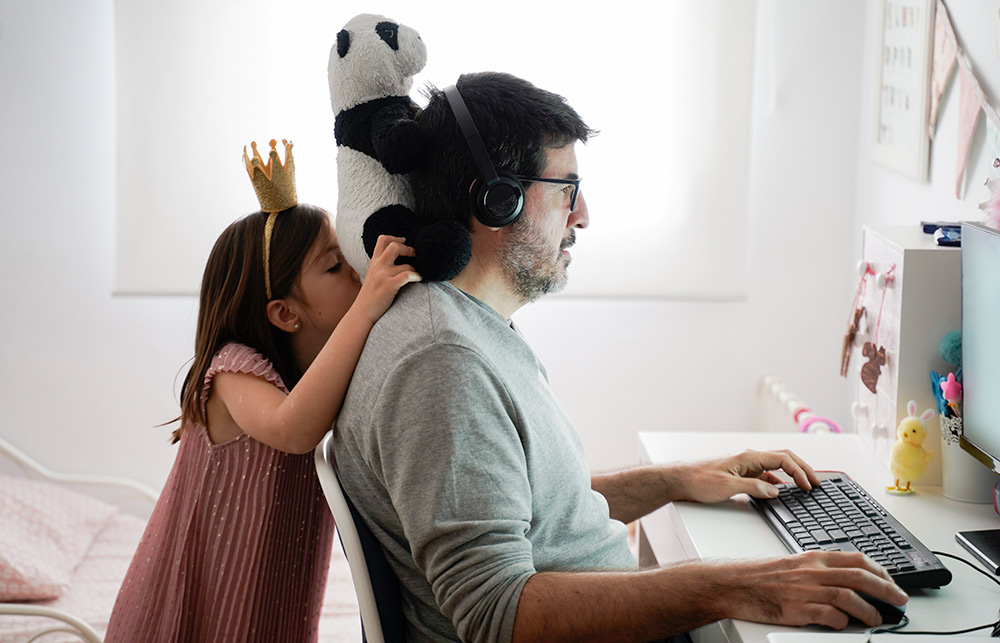
总体而言,居家办公趋势对爸爸们的影响较小。
在家庭和职场中,男女平等这场战争必败无疑,最终可能演化成一场残酷的“先有鸡还是先有蛋”的两难困境。
在疫情爆发之前,家庭看护工作绝大部分都落在了女性身上。大多数男性表示,他们重视并且希望参与到没有任何报酬的家庭看护工作当中。但左翼智库新美国基金会(New America)的最新报告显示,除了少数有过相关经历的男性以外,大部分男性并没有和配偶平均分担家庭看护责任。
新美国美好生活实验室(Better Life Lab)主任以及该报告的作者布里吉德•舒尔特表示:“男性口头说家庭看护很重要,也认为自己同样应该承担该责任,但他们并未付诸实际行动。”
舒尔特认为,男性只有真正经历过家庭看护经历之后,“他们才会有所改变,无论他们是主动选择还是迫于无奈,这都是他们人生中一段变革性的经历。所以对于整个社会而言,我们该如何促成男性从‘心动’(认为家庭看护重要并且自己也应该参与其中 )到‘行动’呢?”
新美国美好生活实验室在2019年调查了超过2,900名成年人,当时学校和日托中心还没有因为新冠疫情被迫停课,女性在就业市场的地位也没有一朝就退步到三十年前。但该基金的调查结果显示,相比男性,女性在经济上受到疫情严重影响的诸多原因更加突出。
超过80%的男性和91%的受访者告诉舒尔特,他们认为男性和女性应该平均分担家庭看护工作。但只有46%的受访者表示,他们是平均分担这些责任的;有45%的受访者表示这些责任主要由女性承担,只有4%的受访者表示男性承担了主要的家庭看护责任。
新美国美好生活实验室针对有过家庭看护经验男性的回答进行了深入分析。这些男性作为父母和“高强度”家庭看护人员,需要照顾身患疾病或有行为障碍或有其他特殊需求的成年人或儿童。无论是调查结果还是焦点小组采访都发现,男性提供家庭看护的经验越多,就越有可能承担起更多责任,而且他们会与职场女性一样面临许多工作/生活相互冲突的问题。
提供“高强度”家庭看护的男性和女性离开劳动力队伍的比例相当,这一点或许最值得注意。在这个群体中,50%的男性和51%的女性表示,他们为了履行家庭看护的义务离开了劳动力队伍或者提前退休。此外,这个群体中,男性和女性为提供协助被迫请假(男性64%,女性71%)和减少工作时间(男性42%,女性45%)的比例同样接近。
无论对于男性还是女性而言,这项调查的结果都很难让人满意。但这项调查凸显出目前女性面临的就业危机在很大程度上源于家庭看护危机,这与我们在新一期《财富》杂志中的观点相同,同时这也证明为了给所有看护者创造更好的就业环境、必要的带薪事假、更多联邦儿童看护支持和其他政策干预是必不可少的。
舒尔特表示:“女性经常首当其冲要承担家庭看护责任,而且她们的就业会首先受到冲击。但需要提供高强度护理男性同样面临巨大压力,然而我们的工作场所并未对此做出回应。”
她补充说:“如果所有人都希望女性离开职场或者停止工作,他们是在指望男性继续工作。男性应该承担起养家糊口的全部责任。我们需要制定公共政策,也需要规范职场实践,为承担家庭看护责任的所有人提供支持。”
自2月以来,有超过540万女性失业,占疫情期间美国净失业人口的一半以上,另外有近210万女性彻底退出了劳动力队伍。(美国劳工部将在周五发布1月份的月度就业报告,我们将在当天更新对女性就业危机的最新分析。)
与此同时,没有子女或不承担“高强度”看护责任的男性面临的工作与家庭义务之间的冲突要少得多。41%的男性“高强度”看护者对新美国美好生活实验室表示,他们不得不将工作延期,因为他们需要拿出更多时间照看家人,相比之下其他父亲的比例为33%,不承担家庭看护责任的男性比例只有10%。
舒尔特表示:“对于性别平衡,我们总是在夸夸其谈,而在实际中,我们并没有为在职场实现性别平衡做出切实努力。如果男性‘应该’养家糊口,但他们又要承担高强度的家庭看护责任,因此不得不缩短工作时间和退出劳动力队伍,这一现实矛盾足以证明当前的制度并不合理。否则,我不知道对此还能有什么更好的解释。”(财富中文网)
翻译:刘进龙
审校:汪皓
总体而言,居家办公趋势对爸爸们的影响较小。
在家庭和职场中,男女平等这场战争必败无疑,最终可能演化成一场残酷的“先有鸡还是先有蛋“的两难困境。
在疫情爆发之前,家庭看护工作绝大部分都落在了女性身上。大多数男性表示,他们重视并且希望参与到没有任何报酬的家庭看护工作当中。但左翼智库新美国基金会(New America)的最新报告显示,除了少数有过相关经历的男性以外,大部分男性并没有和配偶平均分担家庭看护责任。
新美国美好生活实验室(Better Life Lab)主任以及该报告的作者布里吉德•舒尔特表示:“男性口头说家庭看护很重要,也认为自己同样应该承担该责任,但他们并未付诸实际行动。”
舒尔特认为,男性只有真正经历过家庭看护经历之后,“他们才会有所改变,无论他们是主动选择还是迫于无奈,这都是他们人生中一段变革性的经历。所以对于整个社会而言,我们该如何促成男性从‘心动’(认为家庭看护重要并且自己也应该参与其中 )到‘行动’呢?”
新美国美好生活实验室在2019年调查了超过2,900名成年人,当时学校和日托中心还没有因为新冠疫情被迫停课,女性在就业市场的地位也没有一朝就退步到三十年前。但该基金的调查结果显示,相比男性,女性在经济上受到疫情严重影响的诸多原因更加突出。
超过80%的男性和91%的受访者告诉舒尔特,他们认为男性和女性应该平均分担家庭看护工作。但只有46%的受访者表示,他们是平均分担这些责任的;有45%的受访者表示这些责任主要由女性承担,只有4%的受访者表示男性承担了主要的家庭看护责任。
新美国美好生活实验室针对有过家庭看护经验男性的回答进行了深入分析。这些男性作为父母和“高强度”家庭看护人员,需要照顾身患疾病或有行为障碍或有其他特殊需求的成年人或儿童。无论是调查结果还是焦点小组采访都发现,男性提供家庭看护的经验越多,就越有可能承担起更多责任,而且他们会与职场女性一样面临许多工作/生活相互冲突的问题。
提供“高强度”家庭看护的男性和女性离开劳动力队伍的比例相当,这一点或许最值得注意。在这个群体中,50%的男性和51%的女性表示,他们为了履行家庭看护的义务离开了劳动力队伍或者提前退休。此外,这个群体中,男性和女性为提供协助被迫请假(男性64%,女性71%)和减少工作时间(男性42%,女性45%)的比例同样接近。
无论对于男性还是女性而言,这项调查的结果都很难让人满意。但这项调查凸显出目前女性面临的就业危机在很大程度上源于家庭看护危机,这与我们在新一期《财富》杂志中的观点相同,同时这也证明为了给所有看护者创造更好的就业环境、必要的带薪事假、更多联邦儿童看护支持和其他政策干预是必不可少的。
舒尔特表示:“女性经常首当其冲要承担家庭看护责任,而且她们的就业会首先受到冲击。但需要提供高强度护理男性同样面临巨大压力,然而我们的工作场所并未对此做出回应。”
她补充说:“如果所有人都希望女性离开职场或者停止工作,他们是在指望男性继续工作。男性应该承担起养家糊口的全部责任。我们需要制定公共政策,也需要规范职场实践,为承担家庭看护责任的所有人提供支持。”
自2月以来,有超过540万女性失业,占疫情期间美国净失业人口的一半以上,另外有近210万女性彻底退出了劳动力队伍。(美国劳工部将在周五发布1月份的月度就业报告,我们将在当天更新对女性就业危机的最新分析。)
与此同时,没有子女或不承担“高强度”看护责任的男性面临的工作与家庭义务之间的冲突要少得多。41%的男性“高强度”看护者对新美国美好生活实验室表示,他们不得不将工作延期,因为他们需要拿出更多时间照看家人,相比之下其他父亲的比例为33%,不承担家庭看护责任的男性比例只有10%。
舒尔特表示:“对于性别平衡,我们总是在夸夸其谈,而在实际中,我们并没有为在职场实现性别平衡做出切实努力。如果男性‘应该’养家糊口,但他们又要承担高强度的家庭看护责任,因此不得不缩短工作时间和退出劳动力队伍,这一现实矛盾足以证明当前的制度并不合理。否则,我不知道对此还能有什么更好的解释。”(财富中文网)
翻译:刘进龙
审校:汪皓
The losing battle for gender equality at home and in the workplace might come down to a brutal chicken-and-egg dilemma.
Most men say they value—and want to participate in—the unpaid caregiving work that women overwhelmingly shouldered even before the pandemic. But the majority of men don’t actually take on an equal share of caregiving responsibilities unless they already have experience doing so, according to a new report from left-leaning think tank New America.
“Men say caregiving is valuable, and they think they should do it equally—but they don’t do it,” says Brigid Schulte, director of New America’s Better Life Lab and the author of the report.
It’s only when men actually get the experience of becoming a caregiver—“whether they choose to, or they have to—that’s what changes them. That’s this transformative experience in their lives,” Schulte says. “So as a society, how do we get men from this abstract notion that care is valuable, and that they should do it, to actually doing it?”
New America surveyed more than 2,900 adults in 2019, before COVID-19 closed schools and day cares and erased three decades of women’s progress in the U.S. workforce. But the organization’s findings highlight many of the reasons why women, and not men, have been so economically devastated by the pandemic.
More than 80% of men, and 91% of all survey respondents, told Schulte that they believe that men and women should equally share in care work. But only 46% of all respondents said that such responsibilities are actually shared evenly, with 45% reporting that they fall primarily on women, and only 4% reporting that they fall primarily on men.
New America dug a little deeper into the responses of men who already have caregiving experience—as parents, and as “high-intensity” caregivers of adults or children with medical or behavioral conditions or other special needs. Both the survey and focus-group interviews found that men with more experience providing care are more likely to take on a larger share of caregiving tasks—and are facing many of the same work/life conflicts that broadly undermine working women.
Perhaps most striking: Men and women who are “high-intensity” caregivers reported leaving the workforce at the same rate. Among that group, 50% of men and 51% of women said they had left the workforce or retired early because of their caregiving obligations. That group of high-intensity caregivers also reported pretty similar rates, regardless of gender, of missing work to provide assistance (64% men vs. 71% women) and of reducing their work hours (42% men vs. 45% women).
These obviously aren’t great outcomes—for men or for women. But they do underline how much the current employment crisis facing women is rooted in a caregiving crisis, as we report in the new issue of Fortune—and how necessary paid family leave, greater federal childcare support, and other policy interventions are to create better employment conditions for all caregivers, regardless of gender.
“Women have always borne the brunt of caregiving responsibilities and of taking the hit at work,” Schulte says. “But men are also under a lot of pressure in these high-intensity caregiving situations—and our workplaces don’t respond.”
“If everybody expects women to drop out or expects women to hold back at work, they expect men to keep working. They’re supposed to be the breadwinners,” she adds. “We need public policies, and we need workplace practices that support all people with caregiving responsibilities.”
More than 5.4 million women’s jobs have disappeared since February—accounting for more than half of all net jobs shed by the U.S. economy over the course of the pandemic—and nearly 2.1 million women have dropped out of the labor force entirely in that time. (We’ll get another update on the unemployment crisis for women on Friday, when the U.S. Labor Department releases its monthly jobs report for January.)
Meanwhile, men who are not parents or who do not have “high-intensity” caregiving responsibilities report much less conflict between their work and home obligations. Among men, 41% of “high-intensity” caregivers told New America they had to put off work because of demands on their time at home, compared with 33% of other fathers and 10% of men who are not already caregivers.
“For all of the lip service that we’ve given to gender equality, we really haven’t done the work that we need to do to make it real in the workplace,” Schulte says. “If men are ‘supposed to’ be breadwinners and providers, but their caregiving responsibilities can be so intense that they’re reducing hours and dropping out of the workforce—you know, if that isn’t a huge sign that the current system isn’t working for anybody, I don’t know what is.”






